Modigliani: Your real duty is to save your dream
For Modigliani, ‘Beauty’, ‘Life’ and ‘Art’ were a sacred, single entity. ‘Beauty’ was at the core of his creative being. The human face and form have, for thousands of years, been the artist’s principal subject. Yet Modigliani depicted both in a way that became, and will remain, entirely his own. Modigliani was a delicate child, and at the age of eleven became ill with pleurisy, the first of three serious childhood illnesses. At sixteen he almost died of tuberculosis. He sensed his life would be brief and that his mission was to create, for the benefit of others, his own vision of beauty and veneration for life. Some months later, in 1901, he wrote from Rome to his artist friend Oscar Ghiglia: "I myself am the plaything of very powerful energies which are born and die. I would like instead that my life is like a very rich river which flows with joy upon the earth. …I am trying to formulate with the greatest lucidity the truths of art and life I have discerned scattered amongst the beauties of Rome; and as their inner meaning becomes clear to me, I shall seek to reveal and to re-arrange their composition, I could almost say metaphysical architecture, in order to create out of it my truth of life, beauty and art."
That Modigliani should, at so young an age, be concerned with extracting from the ruins of ancient Rome timeless truths, in order to ‘rearrange’ them into his own vision of ‘life, beauty and art’, makes this a particularly remarkable visionary statement of intent. And to Ghiglia later that year: "We others (excuse the plural) have different rights from normal people, for we have different needs which place us above – this must be said and believed – their morality. It is our duty never to be consumed by the sacrificial fire. Your real duty is to save your dream. Beauty too has some painful duties: these produce, however, the noblest achievements of the soul."
The passion and clarity with which Modigliani was already able to express such deeply held beliefs reveal his originality; his uncompromising determination to create his own visual aesthetic ideal. And his absolute conviction that he would succeed. His arrival in Paris in the winter of 1906 accelerated this aesthetic, spiritual alchemy as he absorbed into the prism of his extreme sensibility art forms encompassing some four thousand years, among them the art of the Cyclades, ancient Egypt, Greece, the Etruscans, Rome, Asia, Africa and his beloved Italy. But why did each of these seemingly disparate cultures and art forms speak so directly to Modigliani? Where, for him, lay their unifying energy and individual inspiration? And what collective insight do they reveal into his art? The symbolic simplicity of the Cycladic figure and face. The mesmerising aura, from the grave, of Egyptian goddesses and queens. The purity and majesty of Greek sculpture. The gentle humour of Etruscan art. The noble austerity of Roman art. The sensual movement of female Indian dancers. The serenity of Buddhist art. The raw energy of the African artist’s gouged-out portrayal of the human soul. And Modigliani’s deep feeling for his Italian artist ancestors, among them Giotto, Simone Martini, Michelangelo, Botticelli and Titian – with their tender spirituality, humanity and adoration of the human form From each, he took those elements which accorded with his own character and spiritual aesthetic, so that they became naturally and mysteriously fused with his highly personal artistic vision. He was not interested in fleeting stylistic fads for he considered himself part of a timeless, essentially unchanging artistic-spiritual tradition expressing an enduring, inspiring human response to the beauty and mystery of life.
Modigliani’s meeting, in 1910, with Anna Akhmatova coincided, at a critical juncture in his art, with his need to portray the ‘neither real nor unreal angel spirits’ he dreamt of. Sculpture became his principal focus of expression – a vital, cathartic rite of passage for which he chose the elemental, neutrally coloured substance of stone. Through his carvings and related drawings he forged his vision of humanity. Yet whilst many of his faces and figures are anonymous and often androgynous, certain sculptures and drawings directly mirror the appearance and spirit of Anna Akhmatova whose charismatically beautiful, elongated face and body influenced the course of his art. It is often claimed that Modigliani wanted to devote himself to carving in stone and only his delicate health prevented this. However sculpture alone would never have provided complete fulfilment for an artist so in love with drawing and painting, and so able, through them, to convey the subtlest nuance of character, mood and form. Also an artist utterly entranced and captivated by his fellow beings; and intent upon portraying their inner beauty and richness of character. "To do any work, I must have a living person. I must be able to see him opposite me…" Modigliani told the painter Leopold Survage. Modigliani believed, like Keats, that ‘Beauty’ is ‘Truth’, and could save the world. These drawings mirror the mysterious forces acting within and through him, their harmonious, vibrant lines forming visual sounds of sublime, enduring beauty emanating from a place beyond our comprehension. Lunia Czechowska, who sat for one of Modigliani’s last portraits, recounts a moving incident, not long before he died. ‘While I was preparing dinner, he asked me to lift my head for a few moments and by the light of a candle, he drew a beautiful sketch on which he wrote:’ Life is a gift: from the few to the many: from those who know and who have to those who do not know and do not have.
© Estorick Foundation, London.
The melancholy, downward gaze of this powerful head recalls Modigliani’s
The Beggar Woman painted the same year. This moving painting, as with
other major paintings of 1909, was influenced by Cézanne in colour, mood
and design.
In 1907, Modigliani had exhibited at the Salon d’Automne, which was holding
a major retrospective of Cézanne’s work including the first showing of his
late work. The great beauty and intense personal objectivity yet humanity of
Cézanne’s art made a deep impression on Modigliani.
In 1909, Modigliani was introduced by Paul Alexandre to Brancusi who
encouraged him to pursue his sculpture. Brancusi’s sculpture Mademoiselle
Pogany, is similar in shape to this female head and also possesses a certain
dream-like quality.
In 1908, Modigliani painted his first known nudes. This sheet was most
probably drawn the following year. And in its elongated, sensual pose resides
the genesis of his great nudes.
Eerily prescient (and recalling his quoted letter to Oscar Ghiglia, eight
years earlier) is a lyrical, symbolically-flowing energy which also defines
Modigliani’s last three nudes of 1919.
Evident too is his great love for Titian.
This brush drawing is executed with all the freedom yet concentration of a
piece of Chinese calligraphy. It shows a man in deep reflection. And like his
thoughts his identity remains a mystery.
I rarely had a conversation with Modigliani without his reading to me a
few tercets from the Divina Commedia. Dante was his favourite poet. I was
always astonished by the width of his reading. I don’t think I have ever met
another painter who loved poetry so deeply. He could recite by heart verses
from Dante, Villon, Leopardi, Baudelaire, Rimbaud. His canvases do not
represent fortuitous visions. They are a world apprehended by an artist who
has a rare combination of childlikeness and wisdom. When I say child-likeness,
I do not, of course, mean infantalism, a native lack of ability or a deliberate
primitivism; by child-likeness I mean freshness of perception, immediacy, inner
purity. All his portraits are like their models [I judge by those I knew]. But
what is extraordinary is that Modigliani’s models resemble each other. It is not
a matter of an assumed style or some superficial trick of painting, but of the
artist’s view of the world.
He created a multitude of people: their sadness, their frozen immobility, their
hunted tenderness, their air of doom move the gallery visitors.
Ilya Ehrenburg
Its supreme delicacy and purity of line – the head drawn with slightly
increased pressure to make it stand out from the body – likens this
drawing to a single, barely audible violin note whose fragility and
heightened pitch give it a quietly intense, ethereal beauty.
Evident is the drawing’s relationship to Modigliani’s massive, lyrical
Caryatid sculpture – his only crouching Caryatid sculpture.
The oval-shaped face, the expression, rounded body and delicate sensuality
of Blue Caryatid anticipates, and remarkably so, the Seated Nude of 1917.
The tilted head, hair piled high, the gently curving shoulders and sweetness
of expression, seem to foretell Modigliani’s loving 1918 portrait of Jeanne
Hebuterne in the Norton Simon Museum, Pasadena, painted some seven
years later.
That this rare sheet should contain two such tender, sensitive and very
different drawings, and that each should be so prescient of a major late
painting, seems destined to remain a mystery; but again demonstrates
how the genesis of his later works is often so apparent in drawings made
years before.
The lyrical, ballet-like pose of the left arm curved around the top of the head,
and biblical quality of the figure suggest Modigliani might initially have
imagined her as a ‘Rebecca at the Well’ like figure resting a vase upon her
head. Such a pose would have unbalanced this regal figure and diminished
her statuesque grace – hence perhaps her very unusual, vase-shaped torso.
During his formative studies in Italy, Modigliani would have studied Della
Quercia’s portrayal of divine feminine grace which perhaps influenced this
drawing.
The short, rhythmic, ‘chiselled’ strokes around the head, and
delicate line of the eyebrows ‘flowing’ into the bridge of the
nose, suggest this drawing was done at about the same time as
his finely carved Head of a Woman.
It is fascinating to consider this mysterious, anonymous
head in relation to the portrait of his lover Beatrice Hastings,
painted some five years later.
Akhmatova almost certainly inspired this drawing. The nose is Egyptian
but the mouth, jaw-line, shape of the head and aura of other-worldliness
belong, as the photograph shows, to Akhmatova.
The closed eyes and sensual body, in motionless movement, poised
symbolically in an erotic trance, above a single lit candle, reveal the spell
she had cast over him.
Her stylised posture resembles that of ancient Egyptian female figures,
including those in the Louvre, which Modigliani would have studied, side
by side with Akhmatova.
Christiane Mancini was an actress. While studying at the Paris
Conservatoire, she was briefly Jean Cocteau’s lover. Her intensity
apparently frightened him so that he rebuffed her. Her cat-like eyes,
pursed mouth and thickly encasing hair; also the impression that she
might, in an instant, spring up are all aspects of this refined drawing.
A born psychologist, perceptive and subtle, he had by this time
found his true path. He read the character of someone near him very
accurately and quickly. This psychological gift was such that you could
say that his sitters resembled their portraits rather than vice versa.
He underlined and exaggerated the characteristics of his sitters and
brought out what was hidden by secondary and subsidiary features.
These portraits go far beyond the acuteness of caricature, for in their
truthfulness they attain a high level of style. Sometimes he would say,
‘I’ve found the means that will allow me to express myself.’ And again,
‘What I see before my eyes is an explosion which forces me to express
myself.’ And again, ‘What I see before my eyes is an explosion which
forces me to take control and organise.’ It was by geometry, proportion
and rhythm that he achieved his aims.
Dr François Brabander
1918
Oil on canvas
46 x 38cm
Courtesy: Estorick Collection.
Modigliani retained an abiding love for Italy, yet from 1906 he spent very little time there.
The yellow ochres, burnt siennas and venetian reds used in many of his later paintings –
Dr Brabander among them – reflect, subconsciously perhaps, the beautiful, often faded
colours of sun-bleached buildings remembered from his native land.
Dr François Brabander (Franciszek Brabander) was born in Krakow in 1887. He moved
to Paris around 1910 to study medicine. He married Sophie Sierzpowska, a fellow
Pole studying law at the Sorbonne and sister of Anna Zborowska, wife of Leopold
Zborowski who later became Modigliani’s dealer. Both Anna and Leopold modelled for
several portraits.
At the outbreak of war, Dr Brabander volunteered as a doctor at the front and his
wife as a field hospital nurse. During short leaves from the horrors of the front, Dr
Brabander visited the Zborowski’s in Nice. There, in 1918, Modigliani, painted him in
his military jacket.
Dr Brabander qualified as a doctor in 1919 and because of his valiant war contribution
was granted French citizenship. He practiced in Paris and in the mining town of
Lens, 200 km north of Paris, where he cared for the Polish miners. He and Sophie had
two children and lived happily in Paris until the German occupation in 1940. After
unsuccessfully attempting to escape with his family to London, he joined the French
and Polish French resistance (his unit being codenamed ‘Monika’). In September 1943,
he, and his family were arrested. His wife and daughter were transported to Auschwitz
where they perished in 1943. He was sent to Sachsenhausen concentration camp in
Germany, working as a doctor in the cellulose factory, one of the camp’s numerous
manufacturing units. In April 1945, many prisoners were moved to Bergen-Belsen where
Dr Brabander died the following month. His son Romuald survived; and commemorated
his family with a white marble grave stone. It lies next to the graves of Leopold and Anna
Zborowski, in the Paris cemetery of Père-Lachaise where Modigliani is also buried.
Nude with Cup
c.1916
Watercolour, Indian ink and pencil 64.5 x 50 cm
Courtesy: Estorick Collection.
Modigliani’s drawing is supremely elegant. He was our aristocrat. His line, sometimes
so faint it seems the ghost of a line, never gets bogged down, avoiding this with the
alacrity of a Siamese cat.
Modigliani never consciously stretches faces, exaggerates their lack of symmetry,
gouges out an eye or lengthens a neck. All that happens in his heart. That’s the
way he used to draw us, ceaselessly, at the Rotonde. That’s the way he judged us,
experienced us, loved us and argued with us. His drawing was a silent conversation.
A dialogue between his line and ours. And from this tree, planted so firmly on velvet
legs, so difficult to uproot once it had taken root, the leaves fell and were strewn all
over Montparnasse.
If his models ended up by looking like one another, this is in the same way that
Renoir’s models all look alike. He adapted everyone to his own style, to a type that he
carried within himself, and he usually looked for faces that bore some resemblance
to that type, be it man or woman. This resemblance is so pronounced in Modigliani’s
work that, as with Lautrec, it becomes self-evident and strikes those who never knew
the models.
But the resemblance is only a pretext through which the artist affirms his own identity.
Not his physical identity, but the mysterious identity of his genius. Modigliani’s
portraits, even his self-portraits, reflect his internal, not external, line; his noble, keen,
slender, dangerous grace, like the horn of a unicorn.
In addition I would like to repeat that Modigliani did not paint portraits to order. His
drunkenness, his growling and roaring, his unwonted laughter – he exaggerated all
these to protect himself from importune bores whom he then insulted by his arrogance.
At the end of his short life, he set to work on a stream of nudes and female figures that
is now flowing into museums all over the world. Others will write of his aesthetics.
Here I want to give precedence to the artist and his works, in which all the proud
individuality of his nature is expressed.
Jean Cocteau
Caryatid Seated on Plinth with Lighted Candles
n.d
Black crayon
42.7x26cm
Courtesy: Richard Nathanson, London. Modigliani’s admiration for the serene beauty and quiet strength of the
Buddha figures he saw at the Musée Guimet is evident in this gently erotic,
otherworldly drawing.
The sculptor Jacob Epstein remembers seeing Modigliani’s studio filled with
nine or ten long heads and one figure. ‘At night’, Epstein recalled, ‘he would
place candles on the top of each one and the effect was that of a primitive
temple.’ According to his dealer, Paul Guillaume, Modigliani dreamt of
creating a temple to mankind.
The caryatid was a supporting feature in classical Greek architecture as in the
caryatid figures on the Erechtheion at The Acropolis. And thinking perhaps
of the Greek god Atlas condemned to support the sky on his back, Modigliani
created his own symbolic caryatids whose ‘Beauty’ would save the world.
Portrait of Maud Abrantès
1908
Watercolour with traces of black crayon 41 x 32 cm
Courtesy: Richard Nathanson, London
Kneeling Blue Caryatid
c.1911
Blue crayon
43 x 26.5 cm
Courtesy: Richard Nathanson, London. What I am searching for is neither the real nor the unreal, but the mystery of
what is instinctive in the human race, wrote Modigliani in 1907.
Anna Akhmatova [1889-1966] is considered, with Boris Pasternak and
Osip Mandelstam, the greatest Russian poet of the twentieth century. She
met Modigliani in 1910 on honeymoon, during her first visit to Paris. She
returned alone in early 1911 and they became very close.
Akhmatova’s charismatic beauty and grace; her dream-like otherworldliness
and passion for poetry; and her extraordinary, elongated, sensual body had
a mesmerising effect on Modigliani and played a crucial role in defining the
ideal visual form he had been ‘searching for’ to express, most completely and
beautifully, his artistic-spiritual vision.
Unlike the many caryatid figures Modigliani drew whose faces portray
anonymous, often androgynous beings, this drawing portrays a human face
which, as the photograph on p.62 shows, is almost certainly a most tender
and loving portrait of Anna Akhmatova with her oval-shaped face, noted
fringe and long, graceful body.
Columbine with Fan and wearing a Tutu
1908
Black crayon
31 x 24.3cm
Courtesy: Richard Nathanson, London
Male Head & Shoulders
c.1911
Blue crayon
42.8 x 26.7 cm
Courtesy: Richard Nathanson, London. The elemental simplicity and continuing mysterious beauty
and power of the Head of an Idol, some 4000 years after its
creation, would have profoundly inspired Modigliani.
Whilst this drawing cannot be considered a direct study
for Modigliani’s Sculpture Head in the Gwendolyn Weiner
Collection it can be related to it by the closeness of the tightlyset
eyes, the tiny compressed mouth, small ears, swept-back
hair, curved lower jaw and chin, and elongated neck.
Inspirations.
Francesco Vezzoli: Antique not Antique
Francesco Vezzoli at MUSEO MUSEION.
Surrealism
Inspired by Surrealism and some of the artists of that time (such as Dali or Ernst), I created basic...
Arte generativo
Ejemplos de arte generativo que sirvan de inspiración
Rudolf Belling
Rudolf Belling was sculptor, designer, architect and stage designer. In 1908, he founded a studio fo...
CoBrA Magazines
The avant-garde art collective CoBrA (Copenhagen, Brussels and Amsterdam) existed from 1949 to 1951....
The Venice Pavillon
The Venice Pavillon interprets the history of Venice as a point of contact between West and East. Sh...
I See Violence in Your Eyes (I-VIII)
Pigment, graphite, charcoal, & mixed media on paper.
Trajectories of the Lost, Fallen, Forgotten, and Most Unclean
Ink, graphite, pigment, & mixed media on paper.
Who made this chair????
mystery chair...metal work reminds me of Robert Slezák. Limited chair production by Dupre-Perrin in...
Alessandro Mendini 1931-2019
For Alchimia, design is a cyle: everything that will have to happen has already happened, and the im...
VAW
In late 2018, we proposed a strategic repositioning of Vienna Art Week.
We suggested a fundamental...
Kunio Makaewa
Kunio Maekawa was a master of Japanese modernist architecture. He learned under Le Corbusier and was...
Pieter Bruegel
During his lifetime, Pieter Bruegel the Elder was already among the period’s most sought-after art...
Territorium: Ars - Techne-Krafts-Cosmovisión
Colección de imágenes que soportan investigación a nivel de postgrado: Maestría
Estudios Territ...
Writing & Design
Artists Abroad: A Woman´s Journey to Discover the Artists. Writer and Illustrator.
Writing & Design
SQT..or Not. Book. Writer and Illustrator, Ted Wells.
WRECK--Regeneration Experiment of Wasted Daily-use Ceramics from Chaozhou, China
WRECK, the destruction of decorum, the ruin of culture. BENTU went deep into daily-use ceramics indu...
The loft bar
Concept project of loft bar.
Stories of You
REVOIR is an interactive mirror, activated by emotion detection to create stories through visual lan...
One Hundred Thousand Games
One Hundred Thousand Games is an online game with unlimited levels. It takes the genre of first-per...
Art Driver
A obstacle driving computer game with visual art. Use the arrow keys on your keyboard to push obsta...
The Joys of Ice Skating
That skating 400 years ago was one of the most popular winter activities in the Netherlands can be s...
penccil: This was 2017
The penccil year in review is a project selection for 2017, this year curated by Mario Gagliardi. Se...
serpentine 2017
exhibition, schauspiel köln, cologne. steelobjects, ceramic reliefs.
BS1
temporary accessible sculpture.
We Ar
University of Sunderland MA Glass and Ceramics Show
UNTITLED PROJECT: CABIN [THOREAU]
UNTITLED PROJECT: CABIN [THOREAU] [ANGLET], 2016 –– a carved and painted replica of Henry David ...
Untitled Project: Honda CB77 Superhawk
UNTITLED PROJECT: HONDA CB77 SUPER HAWK, oil paint on carved wood, 2013-2014 –– A carved/painted...
ARCHITETTURA ANALOG(IC)A massimo gasperini
MASSIMO GASPERINI_(Pisa, 1971) architect and researcher in the Representation Sciences, former lectu...
Vico Magistretti
Vico Magistretti (1920 - 2006) studied in Lausanne and Milano. He was one of the main protagonists o...
Franz Kline
Around 1950, Franz Kline radically simplified painting: “Instead of making a sign you can read, yo...
Gaetano Pesce: Abstraction is boring
"Abstraction is boring and limited as a mode of expression. Reducing and reducing designs means that...
Chromatic seating
3 colorful seats by 3 Italian designers: Giancarlo Zema graduated from the Faculty of Architecture o...
New Generation
Experiemntal art
What Is A Simulation?
What is a simulation?
It is a private game we devise when the aliveness of a situation is too comple...
The art of improvising art
The recently abandoned administrative headquarters of Austrian Post, an imposing turn of the century...
Books of Memory: Gianpaolo Pagni
Gianpaolo Pagni creates unique, printed, painted or stamped books. His work focuses around memory an...
Memphis Posters
4 posters by the legendary Italian design collective Memphis Milano.
Just Before Paradise
“And just as we learn about our lives from others, so, too, do we let others shape our understandi...
Kippenberger
Martin Kippenberger (born 1953 in Dortmund, died 1997 in Vienna) is one of the foremost and simultan...
“I perhaps owe it to flowers that I became a painter.”
Arguably the most important painter of gardens in the history of art, Monet was also an avid horticu...
Expression/Information
Painting is seen as a form of practice that—contrary to canonical accounts—in no way shies away ...
Total Automation
In The Promise of Total Automation, artists examine technology in its complexity. They point out our...
German Art since 1960
German ‘paragons of painting’ such as Georg Baselitz, Jörg Immendorff and Markus Lüpertz have ...
Jean Lurçat
Jean Lurcat, painter, poet and ceramicist, great renovator of contemporary French tapestry, produced...
Joe Colombo: Total Furnishing Unit
The Total furnishing unit: Bathroom by Joe Colombo, Milano 1971.
Scum Pixel
'Scum' refers to a foamy layer or mass that forms on the surface of liquid when it is boiled or ferm...
Microscopes of utopia
This are some of landscapes spaces of nowhere with spaces inside
Carlo Scarpa: Sketch and Work
There is hardly another architect of the 20th century in whose work the progression from sketch to c...
Andy Warhol: Endangered Species
In 1983, Andy Warhol expressed his love for animals and his concern for the environment in a series ...
The Bauhaus Revolution
The Bauhaus was the most influential design school of the 20th century.
See more in the new magazin...
In Infinity
Yayoi Kusama’s unique imagery spring from the recurring hallucinations that have haunted her since...
E=C=L=I=P=S=E
Cerith Wyn Evans is a Welsh sculptor and filmmaker. He worked as an assistant to Derek Jarman, at th...
In Orbit
"When I look at these complex layers of translucent lines and spheres, I am reminded of models of th...
Sislej Xhafa
Sislej Xhafa has furnished the waiting room of a police station in Gent like a grand palace. He pres...
Future Architecture
Future Architecture Platform is a European program which promotes talents in architecture. Future A...
Superstudio, Superproduction, Superconsumption
Superarchitecture is the architecture of superproduction, of superconsumption, of superinduction to ...
reversed silhouettes
.......
Heartbeat, Heartseat
Heartbeat consists of a massive heart glowing to the rhythm of a strong, deep and low frequency hear...
Eric Giraudet de Boudemange
Eric Giraudet de Boudemange (1983) graduated in 2007 from the National School of Fine Arts in Paris ...
Christian Herdeg: Kunst und Bau
Christian Herdeg was born 1942 in Zurich. Trained as a photographer, cameraman and lighting technici...
Une Cité Industrielle by Tony Garnier
Tony Garnier designed the plans of an ideal city during his stay at the Villa Médicis from 1899 to ...
Obsolete Distinction
In contemporary society, the digital world pervades the physical to such an extent that any distinct...
HOKUSAI X MANGA
Courtesans, Heroes, Stars and Phantoms - In the early seventeenth century, Edo, which was the bigges...
L’ITALIA CI GUARDIA
On the occasion of the 70th anniversary of the birth of the Italian Republic, 40 masters of photogra...
“I’m not supposed to talk about it”
Nine artists were invited to exhibit in Pyongyang, the North Korean capital of the unknown. The enti...
Francois Morellet 1926 - 2016
Since he first began making work in the 1950s, Morellet has been engaged in creating work which has ...
20th Century Italian Tables
A collection of 20th century Italian table designs.
Xavier Antin: Printing at Home
A printer manual to disturb and disrupt the printing process.
Xavier Antin, born in 1981, lives and ...
The Oily Actor
“I had been looking around these ideas of systemic crisis, global financial crisis, which is what ...
also:
drawings
sneak peek
Earth Works
Multi-collage research, between objects, land art and drawing.
Field of Notion
Field of Notion delves into the dichotomies of light and shadows, life and death, creating a series ...
Paintings 2024
An ongoing series of mixed media paintings
Trompe l´oeil
Rugs "Trompe l´oeil".
Design: Mario Gagliardi for Mario and Casa.
gift: 礼物
gift, color on paper, by zhu yuzhou, 2022.
Eden
Paper sculpture
Choreography of pictorial fetishes
Afterword by WM Hunt
These are photographs.
These exist uniquely as photographs. The artist, Manuel ...
McDEAD ..and lovin' it!
In Australia we call McDonalds - Maccas.
Maccas holds a special place in my heart... it's called cho...
MILEY CYRUS is a ZOMBIE
This is an unused piece for the Australian comic ZOMBIE CITIES by Zorab del Rio.
I can understand to...
TOKYO ZOMBIES
This is the inks for TOKYO ZOMBIES,
a piece I did for the Australian comic called ZOMBIE CITIES by ...
SPACE GIRL
Comic Art, Illustration, Art, Line Art, Brush, Comics.
PAISAJES DE L'EMPORDÀ
Collage
CROMOS
Collage
SALTO
Sculpture
HISTORIA DE UN HUEVO
Sculpture
PERSONAJES
Collage
EL CAMINO MÁS LARGO
Sculpture
VEOVEO
Painting
ADELA
Sculpture
SÚBER
Sculpture
EL PAPEL DE LA FAMILIA
Ilustraciones para artículo: El Papel de la Familia (Hospital Sant Joan de Déu) 2023
VIENTO EN POPA
Mixed Technique
PINTAORA
Painting
EQUILIBRIOS
Escultura
Shop Them - DR NOKI T-shirts are here!
penccil is happy to announce its launching of penccil shop <t https://penccil.com/shop with fashion ...
Pianeti
Rug set "Pianeti", designed by Mario Gagliardi for Mario and Casa. Handcrafted in 100% New Zealand M...
Flow
Dining Table "Flow" designed by Mario Gagliardi for Mario and Casa.
curve wood
Title is affranchir la ligne, a public art commission for the lobby of a sports complex, plays with...
briller par son absence
burn wood
Surface N° 2
Arctic Paper presents Surface N° 2 – a second edition featuring a specially curated selection of ...
The Frenchness of Russian Art: Montaigne and Death
"The Frenchness of Russian Art: Montaigne and Death"
105 NY-110, Melville, NY 11747
September 13, 1...
Coloured stones
The coloured stones is use Traditional Chinese Taihu Stone
The painted house
These experimental structures have been created by combining design processes of architecture and gr...
Casa Sperimentale
One of the most visionary built experiments of 20th century architecture was created through the per...
SCARABOOK
SCARABOOK is the combination of Scarabottolo and the English word book (but perhaps we ought to say ...
My calendar
I start to make it in 2000, the year in which the future has passed, at the request of Adriano Mei G...
71 views of the magic mountain
In the days of the first lockdown I started making these drawings, remotely inspired by Hokusai´s "...
on paper books and e-books
these drawings were made thinking about what is happening to the books through various titles of cla...
The Demonstrations series.
A new series of paintings, oil on canvas, that deal with movement, the power and energy of the crowd...
Curtains
A series of watercolour paintings.
Architectural sculptures
Architectural sculptures by K. Kegelmann as part of "Future City" curated by Mario Gagliardi at the ...
Bad design is smoke, while good design is a mirror.
— Juan-Carlos Fernandez
— Juan-Carlos Fernandez
- penccil is free.
- No trackers. No cookies.
Just creativity.
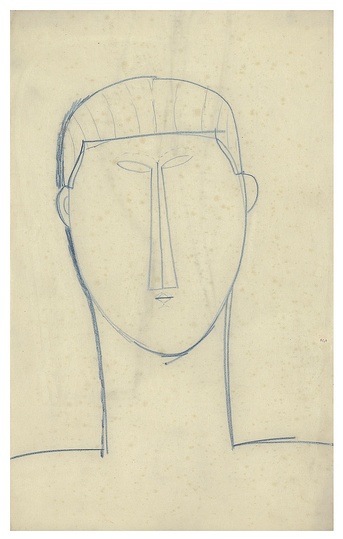





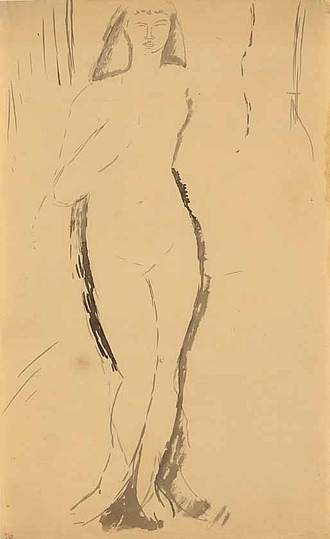





![Modigliani: Your real duty is to save your dream: This brush drawing is executed with all the freedom yet concentration of a
piece of Chinese calligraphy. It shows a man in deep reflection. And like his
thoughts his identity remains a mystery.
I rarely had a conversation with Modigliani without his reading to me a
few tercets from the Divina Commedia. Dante was his favourite poet. I was
always astonished by the width of his reading. I don’t think I have ever met
another painter who loved poetry so deeply. He could recite by heart verses
from Dante, Villon, Leopardi, Baudelaire, Rimbaud. His canvases do not
represent fortuitous visions. They are a world apprehended by an artist who
has a rare combination of childlikeness and wisdom. When I say child-likeness,
I do not, of course, mean infantalism, a native lack of ability or a deliberate
primitivism; by child-likeness I mean freshness of perception, immediacy, inner
purity. All his portraits are like their models [I judge by those I knew]. But
what is extraordinary is that Modigliani’s models resemble each other. It is not
a matter of an assumed style or some superficial trick of painting, but of the
artist’s view of the world.
He created a multitude of people: their sadness, their frozen immobility, their
hunted tenderness, their air of doom move the gallery visitors.
Ilya Ehrenburg](files/table/U_58_9354747450_Estorick_Modigliani__penccil_2_Page_21_Image_0001.jpg)
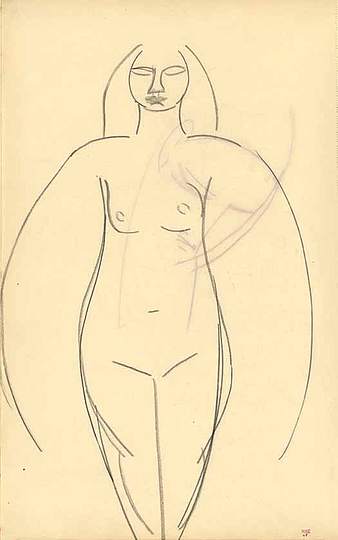
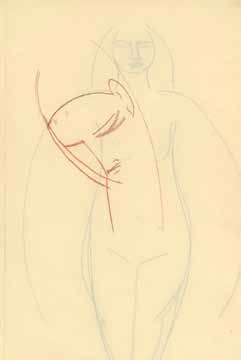




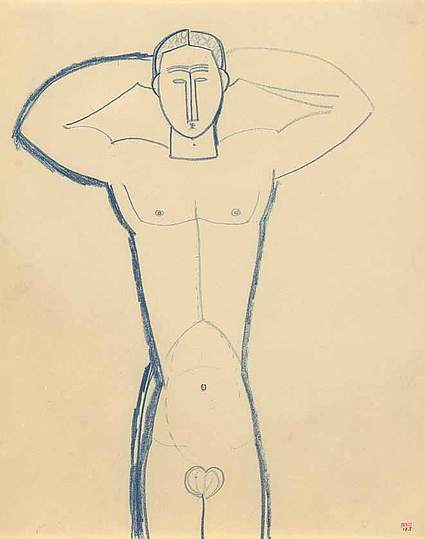
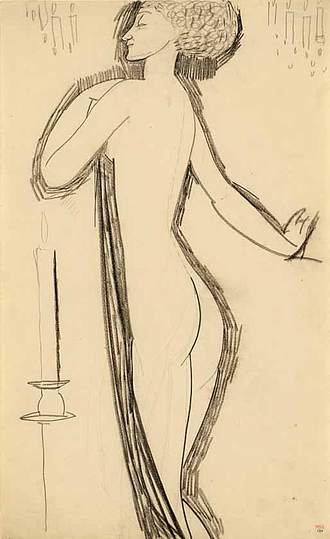



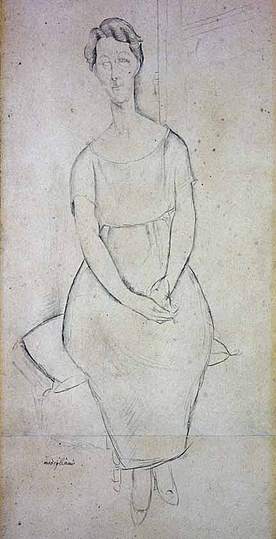





![Modigliani: Your real duty is to save your dream: Kneeling Blue Caryatid
c.1911
Blue crayon
43 x 26.5 cm
Courtesy: Richard Nathanson, London. What I am searching for is neither the real nor the unreal, but the mystery of
what is instinctive in the human race, wrote Modigliani in 1907.
Anna Akhmatova [1889-1966] is considered, with Boris Pasternak and
Osip Mandelstam, the greatest Russian poet of the twentieth century. She
met Modigliani in 1910 on honeymoon, during her first visit to Paris. She
returned alone in early 1911 and they became very close.
Akhmatova’s charismatic beauty and grace; her dream-like otherworldliness
and passion for poetry; and her extraordinary, elongated, sensual body had
a mesmerising effect on Modigliani and played a crucial role in defining the
ideal visual form he had been ‘searching for’ to express, most completely and
beautifully, his artistic-spiritual vision.
Unlike the many caryatid figures Modigliani drew whose faces portray
anonymous, often androgynous beings, this drawing portrays a human face
which, as the photograph on p.62 shows, is almost certainly a most tender
and loving portrait of Anna Akhmatova with her oval-shaped face, noted
fringe and long, graceful body.](files/table/U_58_702190679348_Blue_Caryatid.jpg)



